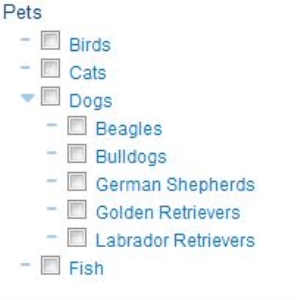Working with the Taxonomy
The Oracle Data Cloud platform uses a hierarchical taxonomy to organize and categorize data. Categories are arranged in a tree structure built to represent the context of a category, using parent-child relationships where the parent is broader conceptually and the child is more precise. This is different from flat-list taxonomies, which are just lists of categories that may or may not be arranged in a specific order, such as a shopping list or the brands section of an e-commerce website. Hierarchical taxonomies require that all categories in a branch have defined relationships between each other, making it easier to navigate and easier to understand a large volume of information.
A small hierarchical taxonomy might be constructed like this: Beagles, Bulldogs, German Shepherds, Golden Retrievers, and Labrador Retrievers are breeds of dogs. Therefore, all of these breeds are placed under the parent category of Dogs.
Parent-child category relationship
Parent and child categories must have a meaningful relationship. When unique profiles are placed into a child category, they are also automatically placed into the broader parent categories. This prevents users from having to select and purchase all child categories individually. Users can simply select the parent category and be confident that any unique profiles in the narrower child are also included.
Both parent and child categories are buckets that can hold unique profiles. For example, there are many more breeds of dogs than the ones included in the preceding child categories above. These five just happen to be the most popular dogs in the United States. In this example, other breeds of dogs did not have a significant enough population to be called out individually, but they are still included in the category of Dogs.
Because the parent category can also hold its own set of unique profiles, the breeds of dogs that are not popular enough to have their own named child category are not lost or ignored. They are aggregated together in the parent category of Dogs. The sum of the unique profiles in the Dogs category follows:
Dogs = Beagle + Bulldog + German Shepherd + Golden Retriever + Labrador Retriever + All Other Types of Dogs
This is a significant difference between a hierarchical taxonomy and a computer-style folder model. In the folder model the folders are merely placeholders for the files at the very bottom of the tree structure. In the hierarchical taxonomy every category can contain its own information.
Category types
Your taxonomy contains the following types of categories:
- First-party categories: Categories in your private first-party taxonomy, which are only available in your DMP. You can create first-party categories in the following ways:
- Taxonomy Manager: Classify your own user data by creating categories, and then creating rules that map the user attributes extracted from your site or offline file into the categories.
- MOS: Oracle Data Cloud’s classification and taxonomy team maps your user data to your custom categories. To request managed taxonomy services, contact My Oracle Support (MOS).
- Second-party categories: Private categories that another DMP partner shared with you using one of the following methods:
- Audience sharing: A DMP partner can share an audience with you so that you can create a data campaign with that audience or analyze the audience. DMP clients typically use audience sharing to send their audiences to an agency who will then run the data campaign for them.
You can use the audience grant API or the audience management tool to share audiences. - Whitelisting: A data provider can share a category in their private taxonomy with you so that you can target, analyze, and model users in that category. A DMP client typically whitelists their consumer data so that another DMP client can use it for some mutually beneficial activation.
You can use taxonomy permissions or the taxonomy partner permissions API to whitelist categories.
- Audience sharing: A DMP partner can share an audience with you so that you can create a data campaign with that audience or analyze the audience. DMP clients typically use audience sharing to send their audiences to an agency who will then run the data campaign for them.
- Third-party categories: Categories in the Oracle Data Marketplace, which are available to all DMP partners.
Working with your taxonomy
The Oracle Data Cloud platform includes two tools for working with your taxonomy:
- Taxonomy Viewer enables you to view your entire taxonomy, including first-, second-, and third-party data. You can't make changes to your taxonomy in Taxonomy Viewer, but you can download it to text file.
- Taxonomy Manager enables you to add categories to your first-party taxonomy and create rules that map your online, offline, and mobile data into your categories. You can make taxonomy updates one-by-one with the UI or batch your updates by uploading files.




